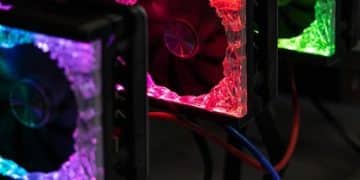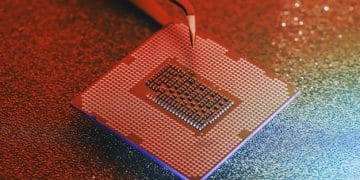How to Calibrate Your Monitor for Accurate Color Reproduction
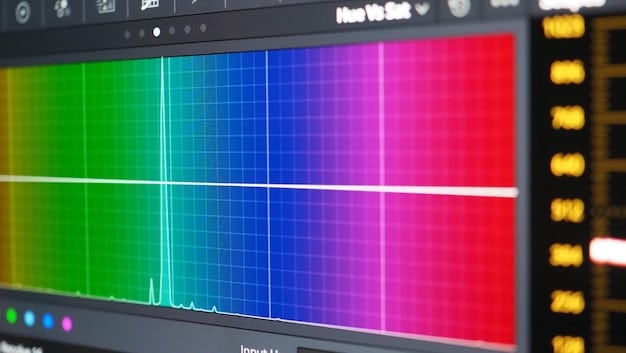
Properly calibrating your monitor ensures accurate color reproduction, which is essential for professionals in graphics, photography, and video editing, and involves adjusting settings like brightness, contrast, and color temperature to match industry standards or personal preferences, resulting in a more faithful representation of displayed content.
Is your monitor’s display true to life? Learn how to properly calibrate your monitor for accurate color reproduction, ensuring what you see on screen matches the final output, saving time and resources in the process.
Why Calibrate Your Monitor?
Monitor calibration is more than just tweaking settings; it’s about ensuring that the colors you see on your screen are accurate and consistent. This is particularly critical for professionals in fields like graphic design, photography, and video editing, where color accuracy is paramount.
Without proper calibration, your monitor might display colors that are either too saturated, too dull, or simply incorrect. This can lead to frustration and wasted time when you’re trying to achieve a specific look or feel in your work.
The Importance of Accurate Color
Accurate color reproduction is essential for delivering professional-quality work. When your monitor isn’t displaying colors correctly, you might make adjustments that actually worsen the final product. For example, you might compensate for a dull display by over-saturating colors, resulting in a final image or video that looks unnatural.
Who Needs Monitor Calibration?
While professionals benefit the most from accurate color, anyone who works with visual content can see improvements. Gamers might want to ensure they’re seeing the game as the developers intended, while casual photo editors can avoid making incorrect adjustments to their images.
- Graphic Designers: Ensuring brand colors are accurately represented.
- Photographers: Editing photos to reflect true-to-life colors.
- Video Editors: Maintaining consistent color grading across projects.
- Gamers: Experiencing games with the intended visual fidelity.
In essence, monitor calibration is a valuable process for anyone who wants to ensure that their visual content is accurately represented.
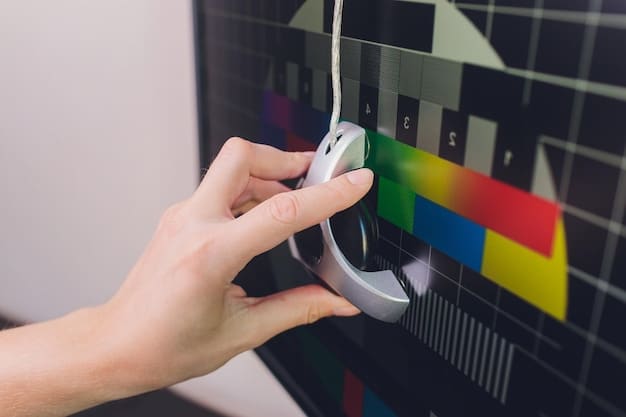
Understanding the Basics of Monitor Calibration
Before diving into the calibration process, it’s helpful to understand the key elements involved. These include color temperature, gamma, brightness, and contrast. Each of these settings contributes to the overall accuracy and consistency of your monitor’s display.
Understanding these basic elements can make the calibration process less daunting and more effective. You’ll be better equipped to make informed decisions and achieve the desired results.
Color Temperature
Color temperature refers to the warmth or coolness of the colors displayed on your monitor. It’s measured in Kelvin (K), with lower temperatures (e.g., 6500K) appearing warmer (more yellow or orange) and higher temperatures (e.g., 9300K) appearing cooler (more blue).
Gamma
Gamma affects the brightness of mid-tones in your images. A gamma of 2.2 is generally considered the standard for computer monitors, as it provides a good balance between dark and light areas.
Brightness and Contrast
Brightness controls the overall luminance of your screen, while contrast affects the difference between the darkest and lightest areas. Adjusting these settings correctly ensures that details are visible in both shadows and highlights.
Understanding these elements is crucial for achieving accurate color reproduction. Now, let’s explore how to achieve this:
Methods for Monitor Calibration
There are several methods for calibrating your monitor, ranging from using built-in software to investing in professional hardware. Each method has its own advantages and disadvantages, so it’s important to choose the one that best fits your needs and budget.
Choosing the right calibration method depends on your specific requirements. If you need highly accurate color for professional work, investing in a colorimeter might be the best option. For casual use, built-in software or online tools might suffice.
Using Built-In Software
Many operating systems and monitors come with built-in calibration tools. These tools typically guide you through a series of steps to adjust brightness, contrast, gamma, and color temperature. While not as precise as hardware calibration, they can significantly improve your monitor’s accuracy.
Online Calibration Tools
Several websites offer online tools that help you calibrate your monitor using visual patterns and instructions. These tools are generally free and easy to use, but they rely on your subjective perception of color, so the results may vary.
Hardware Colorimeters
A colorimeter is a device that attaches to your monitor and measures the colors being displayed. It then uses this data to create a custom color profile that corrects any inaccuracies. Colorimeters provide the most accurate and consistent results, but they can be expensive.
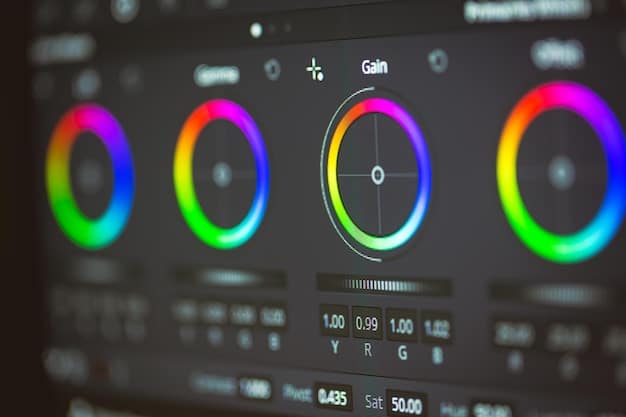
Step-by-Step Guide to Monitor Calibration
Regardless of the method you choose, the basic steps for calibrating your monitor remain the same. Here’s a general guide to help you through the process.
Whether you’re using software or hardware, following these steps can ensure that your monitor is accurately calibrated. Remember to take your time and make small adjustments to achieve the best possible results.
Prepare Your Monitor
Before you begin, make sure your monitor has been turned on for at least 30 minutes to allow it to warm up. Also, clean the screen to remove any dust or smudges that might affect the calibration process.
Adjust Brightness and Contrast
Start by setting the brightness and contrast to their default values. Then, use a calibration pattern or a test image to fine-tune these settings until you can see details in both the darkest and lightest areas of the screen.
Set Color Temperature
If your monitor allows you to adjust the color temperature, set it to 6500K (also known as D65), which is the standard for most displays. If you prefer a warmer or cooler look, you can experiment with different settings, but keep in mind that this will affect the accuracy of your colors.
Adjust Gamma
Use a gamma calibration pattern to adjust the gamma setting until the mid-tones appear natural and balanced. A gamma of 2.2 is generally recommended for computer monitors.
Software for Monitor Calibration
Various software solutions can help you calibrate your monitor effectively. These range from free, built-in tools to professional-grade applications with advanced features.
Using the right software can make the calibration process more efficient and accurate. Experiment with different options to find the one that best suits your needs.
DisplayCal
DisplayCal is a free, open-source calibration and profiling solution that supports a wide range of colorimeters and offers advanced features like profile validation and calibration quality analysis.
BasICColor Display
BasICColor Display is a professional-grade calibration software that provides precise control over color settings and supports a variety of colorimeters. It also offers features like gray balance optimization and ambient light compensation.
X-Rite i1Profiler
X-Rite i1Profiler is another popular professional calibration software that offers a comprehensive set of tools for creating custom color profiles and ensuring accurate color reproduction. It supports X-Rite’s line of colorimeters and spectrophotometers.
Maintaining Your Monitor Calibration
Once you’ve calibrated your monitor, it’s important to maintain its accuracy over time. Factors like aging components and changing ambient light can affect your monitor’s display, so periodic recalibration is necessary.
Maintaining your monitor calibration is an ongoing process. By recalibrating regularly and taking steps to minimize environmental factors, you can ensure that your display remains accurate and consistent.
Recalibrate Regularly
The frequency with which you need to recalibrate your monitor depends on how critical color accuracy is for your work. For professional use, recalibrating every few weeks is recommended. For casual use, recalibrating every few months may be sufficient.
Minimize Environmental Factors
Changes in ambient light can affect your perception of color, so it’s important to minimize these changes as much as possible. Avoid placing your monitor near windows or other sources of direct light, and consider using a monitor hood to block out stray light.
Check Your Color Profile
Your operating system uses a color profile to manage the colors displayed on your monitor. Make sure that the correct color profile is selected and that it hasn’t been corrupted. You can usually find these settings in your operating system’s display preferences.
| Key Point | Brief Description |
|---|---|
| 🎨 Accurate Colors | Ensures what you see on screen matches the final output. |
| 🛠️ Calibration Methods | Includes using built-in software, online tools, and hardware colorimeters. |
| 🌡️ Color Temperature | Adjust to 6500K for standard display accuracy. |
| 🔄 Regular Maintenance | Recalibrate every few weeks for professional use, or every few months for casual use. |
Frequently Asked Questions
▼
Monitor calibration ensures that the colors you see while editing photos are accurate, preventing you from making incorrect adjustments that can ruin the final image. It helps maintain consistency across different devices and prints.
▼
Yes, you can use built-in software or online tools to calibrate your monitor. While not as precise as hardware calibration, these methods can still improve your monitor’s color accuracy and consistency.
▼
For professional use, recalibrating every few weeks is recommended. For casual use, recalibrating every few months is generally sufficient to maintain good color accuracy.
▼
Color temperature refers to the warmth or coolness of the colors on your screen. Lower temperatures appear warmer (yellowish), while higher temperatures appear cooler (bluish). Setting it to 6500K (D65) is generally recommended for accuracy.
▼
After calibrating, check your color profile settings in your operating system to ensure the correct profile is selected. Also, minimize environmental factors like direct sunlight that can affect color perception.
Conclusion
Achieving accurate color reproduction through proper monitor calibration is an essential step for anyone working with visual content. Whether you opt for built-in software, online tools, or professional hardware, taking the time to calibrate your monitor can significantly improve the quality and consistency of your work. By following the steps outlined in this guide and maintaining your calibration regularly, you can ensure that your display remains accurate and true to life, ultimately saving time, resources, and frustration.
